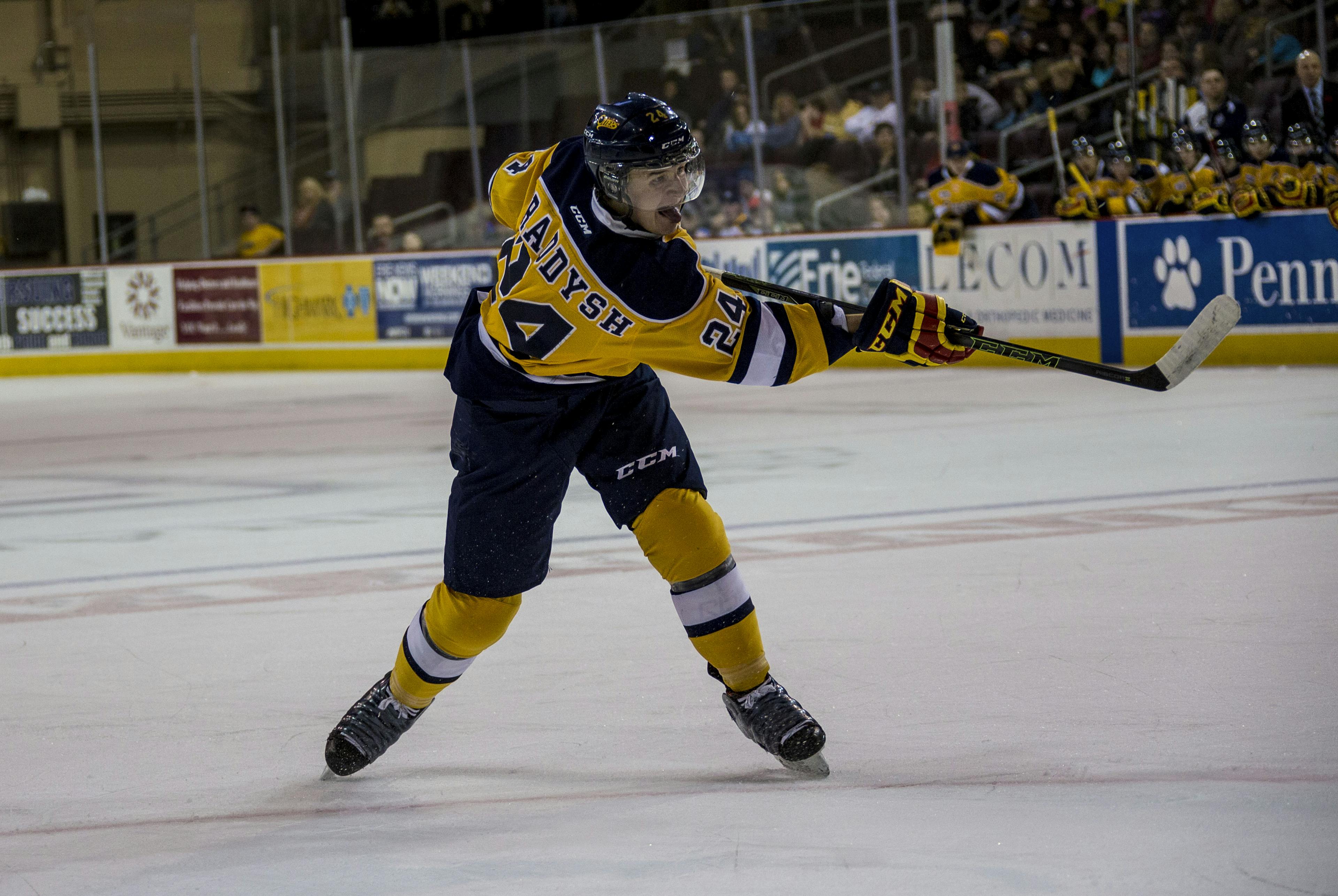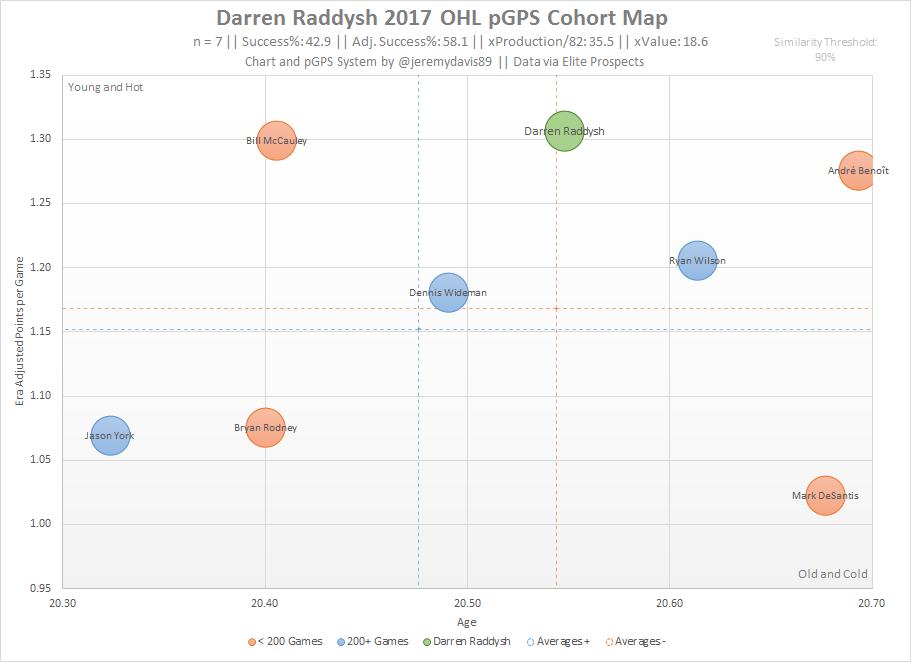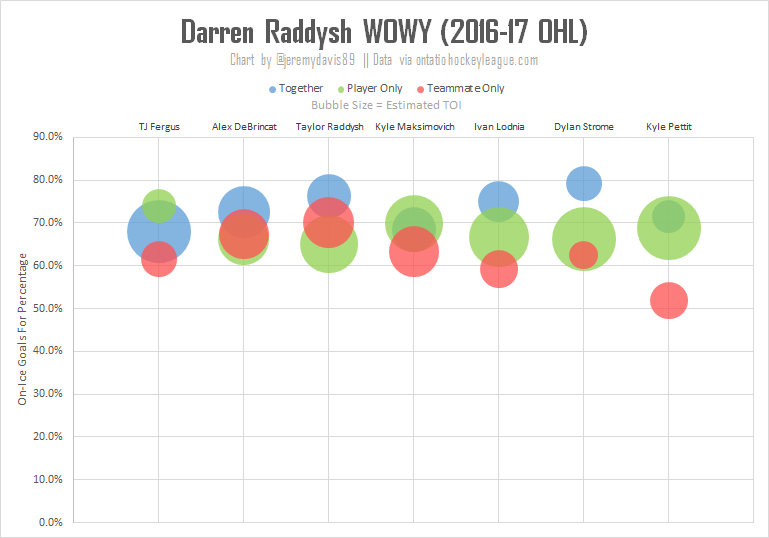A Closer Look at CHL Free Agent Darren Raddysh

By Jeremy Davis
7 years agoLast Tuesday, Sportsnet’s Elliotte Friedman revealed in his ever-informative 30 Thoughts article that the Canucks have interest in signing CHL free agent Darren Raddysh, currently playing in the OHL playoffs with the Erie Otters. The Canucks have made their fair share of Entry Level signings recently (starting with Gatineau’s Zack MacEwen and proceeding to Windsor’s Jalen Chatfield and Western Michigan’s Griffen Molino), and I have been critical more often than not.
A Raddysh signing would be an entirely different story, and though this is little more than a rumour at this point, I already feel better knowing that the Canucks are even pursuing Raddysh in the first place. Raddysh is an two-way defenceman, and a highly productive one at that. Of course there is much more to defencemen than scoring (for instance, while Chatfield’s numbers are significantly more modest, there are visually attractive features of his play that encourage some degree of optimism), but historically successful defencemen, like forwards, tend to produce more points at the junior level.
The Scouting Report
Players that put up numbers like Raddysh has don’t typically slip through the Entry Draft three times without having some warts. A bit ironically, in his draft eligible season (2013-14), a HockeyProspect.com scouting report indicated that he played things a bit too safe, consequently leading him to go through “stretches [of] being unnoticeable because of his defensive first mindset, and ability to consistently, and quietly get the job done.” As far as warts go, this is promising – the OHL’s leading scorer on the blueline was once too focused on his defensive responsibilities, so he’s not your typical case of “high production but can’t handle his own zone” that tends to scare off teams like the Canucks.
Of course, there are other potential issues. I reached out to Brock Otten from OHLprospects.ca, to provide some qualitative analysis before I unleash the quantitative.
Raddysh is an excellent two-way defender. He doesn’t possess elite athleticism or size, which is likely why he has never been drafted. His skating has improved a lot over the course of his OHL career, to the point of it being average now. His straight line speed and acceleration will never be elite, but he’s worked hard to improve his overall mobility to make himself one of the better defenders in the OHL. His gap control and defensive awareness is excellent and he plays with a lot of moxy, be it battling in the corners or putting his body on the line to block a shot. Offensively, he has one of the best stretch passes in the entire OHL and has fantastic vision. His ability to start the breakout is a major asset, as he’s always got his head up, looking to get the puck to Erie’s high powered, skilled forwards. Again, he’s not a dynamic skater and isn’t the type to be a major factor leading a rush deep into offensive territory. Instead, he uses his passing skills, vision, and intelligence to carve apart gaps in the defense. He excels as a powerplay QB for this reason as well.
Otten mentioned that Raddysh’s skating has improved over his OHL career, but still sits only in the average range. In some cases, average can be passable, if the player can make up for it in other areas, especially between the ears. Luckily, Raddysh’s hockey sense and intelligence are frequently commended, including by Otten just a couple of days ago and by the HockeyProspect scouting report nearly three years ago – that bodes well.
Raddysh has been using his brain more than innate ability to put up points this season and in those previous, and doesn’t exactly have a cannon for a shot, but that hasn’t stopped him from putting up three goals in his last two playoff games for the Otters.
His ability to get pucks on net has helped him in this regard. During the regular season, Raddysh was sixth among OHL defenders in shots on goal. In the playoffs, he’s currently fourth in that group, averaging four shots on net per contest.
Statistical Projections
When we run the names of CHL free agents through our Prospect Graduation Probability model, we’re generally pretty pleased when player get a percentage in the double digits. It just isn’t often that players with seriously impressive numbers have been bypassed three times at the draft.
Raddysh is certainly an exception. His sky high numbers net him only a small group of comparables, but it’s a group from which 43% went on to play at least 200 NHL games.

Otten had some thoughts on Raddysh’s future as well:
I think he most definitely has a pro future. Is he a sure thing? Absolutely not. As mentioned, he doesn’t possess elite size or athleticism. But his mind is a major asset and his work ethic and willingness to improve has been evident throughout his OHL career. He’s definitely worthy of an NHL deal. If he continues to improve his skating and gets a bit stronger, I could easily see him developing into a #4-6 defender at the NHL level who can help run a secondary powerplay unit. Sort of like a Cody Franson type. Raddysh is very likely to be the winner of the Max Kaminsky trophy this year in the OHL (best defenseman). The last overage free agent to win the award was Jake Muzzin and he turned out alright for LA. So you never know.
Cohort models are just one way of looking at prospects from a statistical point of view. Statistical projections of success are interesting but provide only a framework. By the model’s own admission, even a player with a likelihood of success as high as 43% is more likely to miss than hit, and pGPS doesn’t give much of an indication as to which side of the ledger the player will fall on.
Because of this, the projected success percentage should be viewed more like betting odds – players with higher odds are safer bets, but having a greater deal of context can help push the needle in one direction or the other. Scouting plays a massive role in that, but from a numbers perspective, that’s where adjusted statistics come in.
Adjusted Statistics
In preparation for the Entry Draft, I’ve been experimenting with expanding on the SEAL adjustments that Garret Hohl created for Hockey-graphs and JetsNation last series prior to the 2016 draft. SEAL was an acronym for secondary assists, era, age and league, the four adjustments to the original formula. I’ve tweaked a few, including making the first adjustment situational and splitting all four into forwards and defenders.
Raddysh already leads all draft-plus-three OHLers in points per game, regardless of position, and across the CHL he trails only 11 players (all forwards). After adjustments, Raddysh trails only Regina’s Adam Brooks of the WHL.
Expanding the sample to all ages and restricting it to defencemen, Raddysh’s 1.31 unadjusted points per game are behind only Thomas Chabot in the QMJHL (1.32 points per game). Even after adding adjustments, including an age adjustment that is supposed to bring his production in line with players in their draft eligible season, Raddysh’s production sits in ninth among CHL defencemen, behind high profile names like David Quenneville, Jake Bean, Jusso Valimaki and Victor Mete – but ahead of other impressive defenders like Mikhail Sergachev, Parker Wotherspoon, Kale Clague, Nic Hague and our own Olli Juolevi.
Part of the reason behind his ability to stick with these younger, more well known players is that the increases in production by age in the CHL is not nearly as steep for defencemen as it is for forwards, resulting in more modest downward adjustments. He also wasn’t sunk by situational instabilities, as his 40 5-on-5 points were among the CHL’s best for defencemen. Though he benefited from a lot of secondary assists, particularly at even strength, research like that in DTMAboutHeart’s WAR model indicates that secondary assists in defencemen do not suffer the same degree of problems with repeatability as they do in forwards.
All of this is to say that, from the standpoint of these adjustments, there are no obvious red flags in his extraordinary production.
Of course, this metric is not designed (at present at least) to account for the quality of teammates that the player is playing with.
Quality of Teammates
One area that may actually give pause is Raddysh’s quality of teammates. The Erie Otters are a dominant offensive force, and scored more goals this season than any other CHL team. Their top line of Dylan Strome, Taylor Raddysh (Darren’s younger brother), and Alex DeBrincat is, in some ways, this year’s version of the London Knights’ 2015-16 top line of Mitch Marner, Matthew Tkachuk, and Christian Dvorak, insofar as all three members might be ready to crack NHL rosters as soon as next year.
Any player that gets that opportunity to spend time with elite level talent is going to benefit from the opportunity. The difficulty is teasing out the effect that each player has on the other.
For his part, Otten believes that Raddysh plays as much a part in Erie’s success as playing for Erie does in Raddysh’s.
While Erie’s high powered offense has no doubt helped to make his statline look sexy, he’s far from being a guy just along for the ride. Erie’s forward’s benefit greatly from his ability to get the puck to them in transition and his ability to make quick decisions most definitely has helped Erie be an offensive juggernaut the last few years.
The statistics seem to match Otten’s eye test. I was able to put together a With-or-Without-You graph for Raddysh’s 2016-17 campaign, featuring his seven most frequent linemates:

Note: Junior WOWY data is not readily available on any sites, and my scraper is currently under repair, so this data is dated February 7th, meaning it’s missing the final five weeks of the season – but still contains a large sample of ~50 games.
First of all, you notice that there’s a lot of white space at the bottom – none of these combinations that involve Darren Raddysh were below 60%. Raddysh was carrying a 5-on-5 goals-for ratio of 69.3%, with many of his linemates carrying similarly impressive on-ice data.
You’ll also notice that while Alex DeBrincat and Taylor Raddysh were slightly better on their own that Raddysh was on his own (the red dots being slightly higher than the green dots), in both case the players were better when they were together (the blue dots being highest of all). Other players including Kyle Maksimovich, Ivan Lodnia, and former Canuck prospect Kyle Pettit seemed to benefit from playing with Raddysh, as did his frequent defensive partner TJ Fergus. Even 2015 3rd overall pick Dylan Strome has better results with Raddysh than away from him.
Summary
As far as overaged CHL prospects go, you won’t find many players with a better likelihood of success than Darren Raddysh. While even he is not guaranteed to succeed in the NHL, his production is highly impressive and stands up well against age and situational adjustments. His on-ice data is fantastic and he appears to be contributing as much to the success of his dominant team as his team is to his individual numbers.
From a qualitative perspective, the fact that Raddysh grew into his offence after beginning his junior career as a defence-first defender should ease the minds of GM’s that are ever concerned about risky offensive defencemen. Raddysh’s mind and offensive and defensive instincts should serve him well as he transitions to the professional game, though his achievements will be dependent on how much he can improve his skating, which is still average.
The Canucks should absolutely be making an attempt to sign Darren Raddysh. At this time, we can only hope that they will adjudge themselves to have enough future contract spots to do so.
Recent articles from Jeremy Davis





